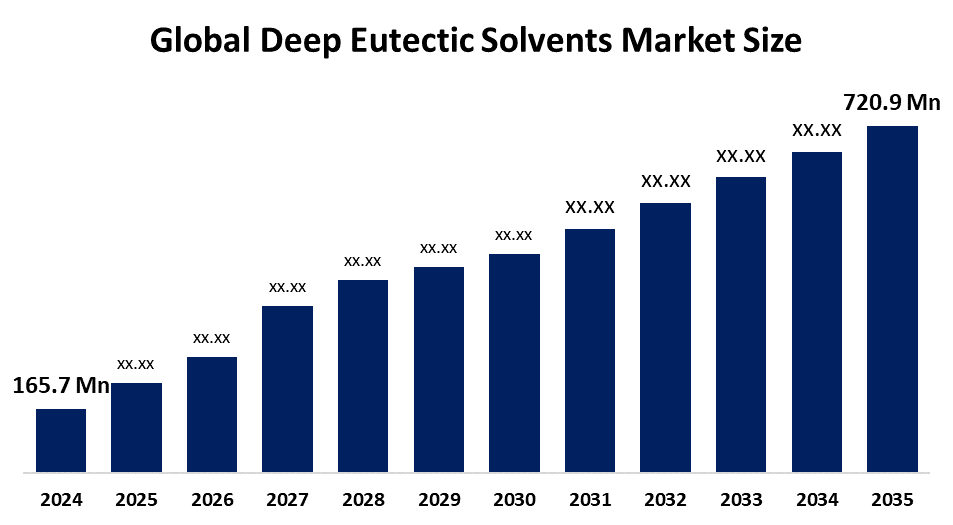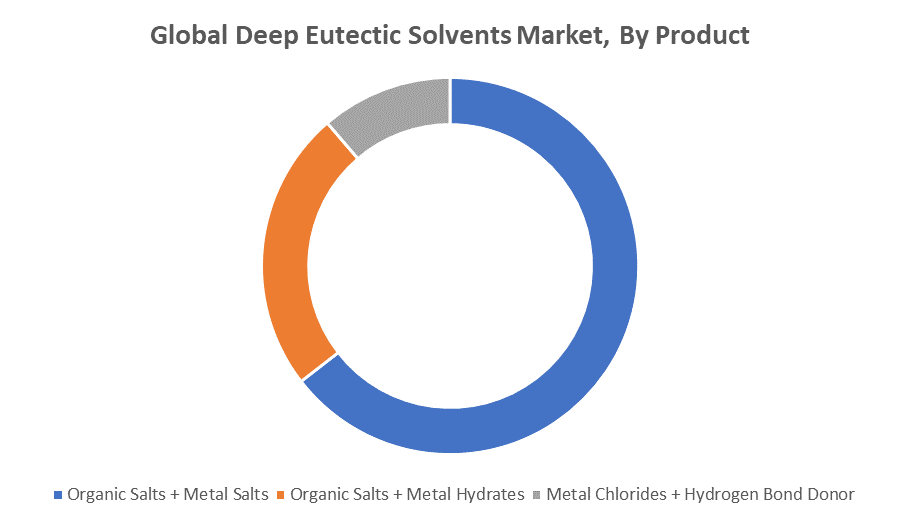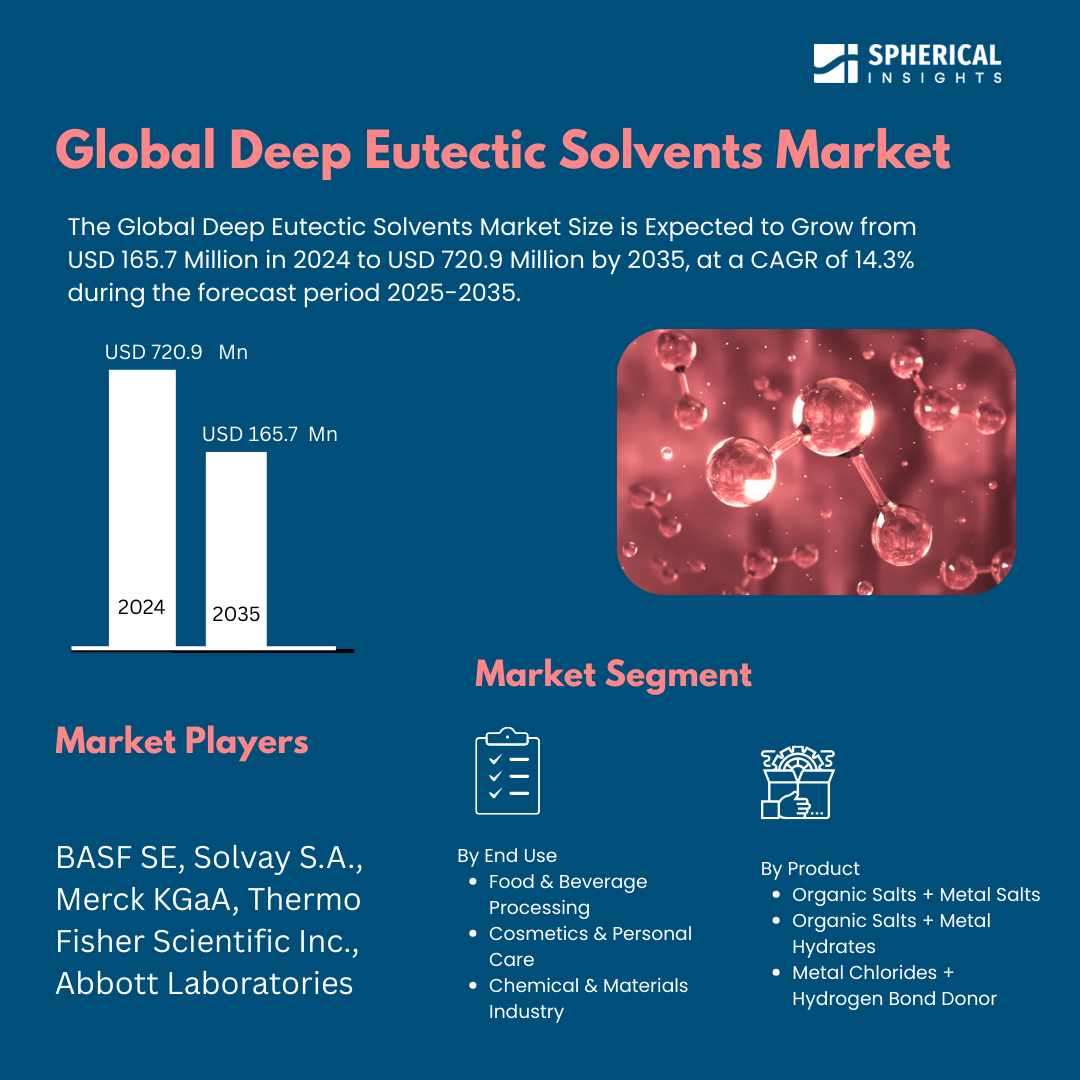Global Deep Eutectic Solvents Market Insights Forecasts to 2035
- The Global Deep Eutectic Solvents Market Size Was Estimated at USD 165.7 Million in 2024
- The Market Size is Expected to Grow at a CAGR of around 14.3% from 2025 to 2035
- The Worldwide Deep Eutectic Solvents Market Size is Expected to Reach USD 720.9 Million by 2035
- Europe is expected to grow the fastest during the forecast period.

Deep Eutectic Solvents Market
The deep eutectic solvents market revolves around the development and commercialization of a unique class of green solvents composed of a mixture of hydrogen bond donors and acceptors. These components, when combined, create a eutectic mixture with a melting point significantly lower than that of the individual constituents. DES are known for their low toxicity, non-volatility, and biodegradability, making them a safer alternative to conventional solvents. They are used across various industries including pharmaceuticals, cosmetics, food processing, and metallurgy, owing to their ability to dissolve a wide range of compounds and their compatibility with different chemical processes. DES also offer flexibility in formulation, allowing tailored properties for specific industrial applications. The market includes a variety of types such as choline chloride-based and natural DES, which vary depending on the components used. The overall DES market is expanding steadily, supported by increasing research interest and broader industrial adaptation of sustainable solutions.
Attractive Opportunities in the Deep Eutectic Solvents Market
- Ongoing research is enabling the creation of customized DES formulations tailored for specific industrial applications. This innovation opens up new possibilities across various sectors such as pharmaceuticals, cosmetics, and chemical processing, expanding the usability and performance of DES.
- There is significant potential in developing DES derived from bio-based, natural, and renewable materials. These green solvents cater to increasing demand for sustainable chemicals, especially in agriculture, food processing, and cosmetics industries, where natural solvent systems are preferred.
- DES present promising opportunities in cutting-edge applications like carbon capture technologies, drug delivery systems, nanomaterials synthesis, and energy storage (e.g., battery electrolytes). These niche areas offer avenues for innovation where traditional solvents often fall short.
- Leveraging waste materials as raw inputs for DES production aligns with circular economy principles. This approach supports sustainability goals and opens new markets for eco-friendly solvents while reducing raw material costs and environmental impact.
Global Deep Eutectic Solvents Market Dynamics
DRIVER: New research is helping create improved DES mixtures
DES are biodegradable, non-toxic, and have low volatility, making them a good fit for industries looking to reduce environmental impact. Many governments and organizations are enforcing stricter rules on harmful solvents, which is encouraging companies to switch to greener options like DES. These solvents are also versatile and can be used in many areas such as chemical processing, food, cosmetics, and pharmaceuticals. They are easy and affordable to make using common ingredients, which adds to their popularity. New research is helping create improved DES mixtures for specific uses, opening more doors for their application. As industries move towards more sustainable and safe practices, the demand for deep eutectic solvents is expected to keep increasing.
RESTRAINT: Lack of large-scale industrial adoption
One of the main challenges is the lack of large-scale industrial adoption, partly due to limited awareness and understanding of DES among end-users. Additionally, the physical and chemical properties of DES, such as high viscosity and slow reaction rates in some applications, can hinder their performance compared to conventional solvents. Compatibility issues with certain materials and limited long-term stability in some formulations may also restrict their use. Another challenge is the absence of standardized regulations and guidelines for DES production and application, which creates uncertainty for manufacturers and users. Furthermore, while DES are often promoted as cost-effective, the need for customization in some applications can increase production complexity and costs. These factors combined may slow down the broader acceptance and commercial scale-up of DES across various industries.
OPPORTUNITY: Development of DES from natural and renewable sources
One major opportunity lies in the development of DES from natural, renewable sources, which can cater to the growing demand for bio-based chemicals. This opens doors for innovation in agriculture and food industries, where natural solvent systems are preferred. There is also potential for DES in niche applications such as carbon capture, drug delivery, and nanomaterials synthesis, where traditional solvents face limitations. In the energy sector, DES show promise in battery electrolytes and fuel processing due to their tunable properties. Collaborations between research institutions and industry players offer further potential to accelerate the development of specialized DES formulations. Additionally, the circular economy trend creates opportunities to use waste materials as raw components in DES production. These emerging areas provide a platform for new product development and expansion into untapped markets, enhancing the long-term prospects for DES.
CHALLENGES: Lack of detailed research on the long-term environmental
One of the main issues is the lack of detailed research on the long-term environmental and health effects of some DES mixtures. While they are often labeled as green, not all types have been fully tested for safety. Scaling up production from the lab to industrial levels can also be difficult and costly. In some cases, companies may face challenges in protecting their unique DES formulations due to limited patent protection. Another challenge is fitting DES into current industrial systems, which may require changes in equipment and processes. In tightly regulated industries like food and pharmaceuticals, getting approval to use new solvents can take a lot of time and money. These challenges need to be addressed through more research, better regulations, and strong industry partnerships to support the wider use of DES in the future.
Global Deep Eutectic Solvents Market Ecosystem Analysis
The global deep eutectic solvents market ecosystem includes raw material suppliers, manufacturers, research institutions, regulatory bodies, and end-users. Key industries using DES include pharmaceuticals, food, cosmetics, energy, and metallurgy. Research institutions drive innovation, while regulatory agencies influence safety and environmental compliance. Distributors and supply chain partners ensure efficient product delivery, and technology providers support production processes. This interconnected ecosystem enables the development, customization, and global distribution of DES, supporting sustainable solutions across various industrial applications.
Based on the product, the organic salts + metal salts segment led the deep eutectic solvents market with the largest revenue share over the forecast period

The organic salts + metal salts segment led the deep eutectic solvents market, holding the largest revenue share over the forecast period. This dominance is due to their enhanced physicochemical properties, such as improved conductivity and thermal stability, making them highly suitable for applications in electrochemistry, metallurgy, and catalysis. Their ability to dissolve a wide range of compounds and compatibility with various industrial processes further drives their demand, contributing significantly to the overall market growth.
Based on the end use, the chemical & materials industry segment led the deep eutectic solvents market with the highest revenue share over the forecast period

The chemical and materials industry segment led the deep eutectic solvents market with the highest revenue share over the forecast period. This is attributed to the widespread use of DES in chemical synthesis, catalysis, and materials processing, where their unique properties improve efficiency and sustainability. The growing focus on green chemistry and environmentally friendly manufacturing processes within this industry further boosts the demand for DES, making it the largest revenue-generating segment in the market.
Asia Pacific is anticipated to hold the largest market share of the deep eutectic solvents market during the forecast period
Asia Pacific is anticipated to hold the largest market share in the deep eutectic solvents market during the forecast period. This is driven by the region’s rapidly growing chemical, pharmaceutical, and electronics industries, along with increasing investments in research and development. Additionally, rising environmental regulations and a strong focus on sustainable manufacturing practices in countries like China, India, and Japan are boosting the adoption of green solvents like DES. The availability of raw materials and cost-effective manufacturing further strengthen the region’s market position.
Europe is expected to grow at the fastest CAGR in the deep eutectic solvents market during the forecast period
Europe is expected to grow at the fastest CAGR in the deep eutectic solvents market during the forecast period. This rapid growth is driven by stringent environmental regulations promoting green chemistry, strong government support for sustainable technologies, and increasing investments in research and innovation. Additionally, Europe’s well-established chemical and pharmaceutical industries are actively adopting DES to meet eco-friendly standards. Growing awareness about the benefits of DES and the focus on reducing harmful solvent emissions further accelerate market expansion in the region.
Recent Development
- In November 2023, Gattefossé SAS launched Natural Deep Eutectic Solvents (NaDES) as eco-friendly, biobased alternatives for advanced plant extraction in cosmetic formulations. These NaDES-based solutions enhance phytochemical content and improve biological efficacy, delivering notable anti-aging and skin health benefits.
Key Market Players
KEY PLAYERS IN THE DEEP EUTECTIC SOLVENTS MARKET INCLUDE
- BASF SE
- Solvay S.A.
- Merck KGaA
- Thermo Fisher Scientific Inc.
- Abbott Laboratories
- The Chemours Company
- Sirrus, Inc.
- GFS Chemicals, Inc.
- Yuncheng Chemphy Chemical Co., Ltd.
- Eutec Solutions
- Shenzhen Capchem Technology Co., Ltd.
- NanJing HPL Chemical Co., Ltd.
- Others
Market Segment
This study forecasts revenue at global, regional, and country levels from 2020 to 2035. Spherical Insights has segmented the deep eutectic solvents market based on the below-mentioned segments:
Global Deep Eutectic Solvents Market, By Product
- Organic Salts + Metal Salts
- Organic Salts + Metal Hydrates
- Metal Chlorides + Hydrogen Bond Donor
Global Deep Eutectic Solvents Market, By End Use
- Food & Beverage Processing
- Cosmetics & Personal Care
- Chemical & Materials Industry
Global Deep Eutectic Solvents Market, By Regional Analysis
- North America
- Europe
- Germany
- UK
- France
- Italy
- Spain
- Russia
- Rest of Europe
- Asia Pacific
- China
- Japan
- India
- South Korea
- Australia
- Rest of Asia Pacific
- South America
- Brazil
- Argentina
- Rest of South America
- Middle East & Africa
- UAE
- Saudi Arabia
- Qatar
- South Africa
- Rest of the Middle East & Africa






